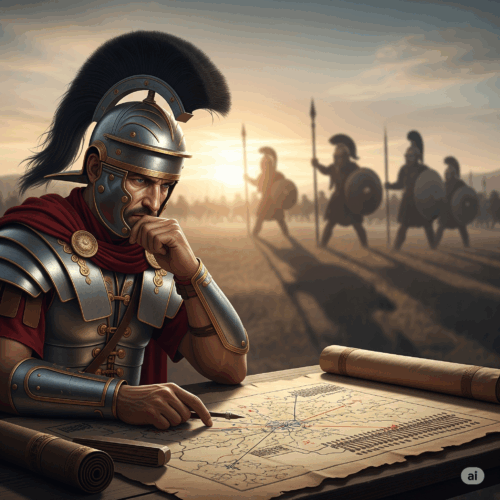On this day, June 22nd, in the year 168 BCE, the fate of a kingdom was sealed in a field in Greece. It wasn’t just another clash of swords and shields; it was a collision of philosophies, a dramatic demonstration of how rigid adherence to a “perfect” but inflexible plan can shatter against the rocks of reality. This is the story of the Battle of Pydna, and its lessons are startlingly relevant to building your own success in the modern world.
On one side, you had the might of the Macedonian Phalanx, led by King Perseus. For centuries, the phalanx was the apex predator of the ancient battlefield. A tightly packed formation of soldiers wielding massive, 20-foot long pikes called sarissas, it was a seemingly impenetrable wall of bristling death. It was organized, powerful, and had a long history of success. In essence, it was the ultimate, time-tested strategic plan.
On the other side stood the Roman legions, commanded by Lucius Aemilius Paullus. The legions were different. They were modular, flexible, and adaptable. Instead of one massive block, they were organized into smaller, more nimble units called maniples. They could operate independently, exploit opportunities, and flow like water over uneven ground.
The battle began, and on the flat, open plain, the Macedonian phalanx was terrifyingly effective. It pushed the Romans back, its wall of pikes proving nearly unbreakable. For a moment, it looked as if Perseus’s textbook strategy would win the day.
But then, something happened. As the phalanx advanced, it moved onto broken, hilly ground. The rigid formation, the very source of its strength, became its critical weakness. Gaps and cracks began to appear in the once-perfect wall of spears. The Macedonian soldiers struggled to maintain their tight cohesion on the uneven terrain.
This was the moment the Romans were waiting for. Paullus ordered his maniples not to attack the front of the phalanx head-on, but to dive into these small, fleeting gaps. The Roman legionaries, with their shorter swords and large shields, exploited the momentary disorder. They turned the Macedonians’ strength against them, getting inside the reach of the long sarissas, where the phalanx soldiers were most vulnerable.
Within an hour, the supposedly invincible Macedonian phalanx was broken, the battle was lost, and the kingdom of Macedon would soon be dismantled by Rome. King Perseus, who clung to a strategy that had worked for his ancestors, lost everything because his plan could not adapt to a change in terrain.
So, what does a 2,193-year-old battle have to do with you navigating your career, personal projects, or fitness goals? Everything. We are all, in a way, commanders of our own lives, armed with plans and strategies. But too often, we fall in love with our “phalanx”—our rigid, beautifully crafted plan—and fail to adapt when we hit the “broken ground” of unexpected challenges, new information, or unforeseen opportunities.
The lesson from June 22nd, 168 BCE, is this: The most successful strategy is not the most powerful or the most traditional; it is the most adaptable. Here is how you can apply the “Roman Maniple” mindset to your own life to ensure your plans don’t shatter when reality strikes.
 Your Personal Plan of Attack: The Modern Maniple Method
Your Personal Plan of Attack: The Modern Maniple Method
Think of your big goal—getting a promotion, starting a business, writing a book, running a marathon—as your “campaign.” Your plan to achieve it is your “army.” Now, let’s stop building a rigid phalanx and start training nimble, adaptable maniples.
Benefit 1: Build a Modular, Not Monolithic, Plan
The Macedonian phalanx was one giant, interdependent unit. If one part failed or got stuck, the whole formation was compromised. Many of our plans are like this. We create a long, sequential list of steps, and if Step 3 gets delayed or becomes impossible, the entire project grinds to a halt.
The Romans, however, used maniples—smaller, independent units that could act on their own. We need to do the same with our goals.
- Specific Application: Break your large goal into smaller, semi-independent “mini-projects” or “sprints.” Each mini-project should deliver a specific, tangible outcome and be workable on its own.
- The Plan:
- Identify Core Components: Take your main goal and break it down into 3-5 major components. For “starting a business,” these might be: 1) Market Research, 2) Product Development, 3) Financial Planning, 4) Marketing Strategy.
- Create “Maniple” Task Lists: For each component, create a separate task list. The tasks for “Market Research” don’t necessarily depend on the completion of “Financial Planning” at the early stages.
- Work in Parallel: Identify which of these “maniples” can be worked on simultaneously. You can research your market while also sketching out initial product ideas. This creates momentum and means a roadblock in one area doesn’t stop all progress.
- Define “Victory” for Each Unit: Each mini-project needs a clear definition of “done.” For “Market Research,” it might be a completed competitor analysis report. This gives you small wins along the way, boosting morale and motivation.
 Benefit 2: Actively Scan for “Broken Ground”
Benefit 2: Actively Scan for “Broken Ground”
King Perseus marched his phalanx forward, assuming the terrain would remain flat and ideal. He wasn’t prepared for the hills. We do this when we assume our career path will be linear, our project will have no budget cuts, or we’ll have uninterrupted time to work out. “Broken ground” is inevitable.
The Roman commander, Paullus, was actively looking for that broken ground. He saw the weakness it created as an opportunity, not a disaster.
- Specific Application: Schedule regular “reconnaissance missions” for your life and projects. These are dedicated times to step back and assess the “terrain” ahead, actively looking for potential challenges.
- The Plan:
- The Weekly “Scout Report”: Dedicate 30 minutes every Friday to review the upcoming week. Ask yourself: What are the potential challenges? Where could my plan break down? (e.g., “My car is making a weird noise, which could disrupt my commute” or “There’s a big company announcement on Wednesday that might change my project’s priorities.”)
- Pre-Mortem Analysis: Before starting a major project, conduct a “pre-mortem.” Imagine it has already failed spectacularly. Brainstorm all the possible reasons why it failed. This helps you identify the “broken ground” in advance and put contingency plans in place.
- Cultivate an “Information Network”: Just as scouts brought back information, stay informed. Talk to colleagues, read industry news, listen to feedback. This isn’t just passive consumption; it’s an active search for information that could impact your plan.
 Benefit 3: Seize the Gaps – Master the Strategic Pivot
Benefit 3: Seize the Gaps – Master the Strategic Pivot
When the gaps appeared in the Macedonian line, the Roman maniples didn’t hesitate. They dove in. This was their moment of opportunity, born from the enemy’s inflexibility. In our lives, these “gaps” are unexpected opportunities, new ideas, or sudden changes that render part of our old plan obsolete.
Clinging to the original plan when a golden opportunity appears is the modern equivalent of staying in formation while the battle is being won elsewhere.
- Specific Application: Develop a bias toward action when unforeseen opportunities arise that align with your ultimate goal, even if they deviate from your original step-by-step plan.
- The Plan:
- Define Your “True North”: Be crystal clear on your ultimate objective, but flexible on the path to get there. The Romans’ goal was to win the battle, not to “defeat the phalanx head-on.” Your goal might be “become a recognized expert in my field,” not just “get promoted to Senior Manager at my current company.”
- The “Opportunity Matrix”: When an unexpected opportunity arises (a new project at work, a chance to collaborate, a new technology to learn), quickly assess it against two factors: 1) How much does it align with my “True North”? and 2) What is the resource cost (time, money, energy)? If it’s high alignment and manageable cost, it’s a “gap” worth diving into.
- Practice Small Pivots: You don’t have to wait for a crisis to practice adaptability. Try a new route to work. Experiment with a different project management tool. Cook a new recipe without slavishly following every step. Building the “muscle” of adaptation in low-stakes environments prepares you for the big moments.
Benefit 4: Equip Yourself with Versatile “Weapons”
A Roman legionary carried a short sword (gladius), a javelin (pilum), and a large shield (scutum). They had tools for different situations. A Macedonian phalangite had one tool: the giant sarissa, which was useless in close quarters.
We often equip ourselves with a single, specialized skill or approach and then apply it to every problem, wondering why it doesn’t always work.
- Specific Application: Intentionally cultivate a diverse toolkit of skills, mental models, and approaches to problem-solving.
- The Plan:
- Skill Stacking: Don’t just go deeper into your primary skill. Add complementary “weapons” to your arsenal. If you’re a great writer, learn basic graphic design. If you’re a data analyst, take a course on public speaking and data storytelling.
- Build Your “Mental Model” Library: Actively learn about different ways of thinking. Read about frameworks like “First Principles Thinking,” “Second-Order Thinking,” or the “Eisenhower Matrix.” When you face a problem, consciously ask, “What ‘weapon’ or ‘model’ is best suited for this?”
- Seek Diverse Experiences: Step outside your comfort zone. Volunteer for a cross-functional project. Travel to a new place. Talk to people from completely different industries. Each new experience adds another versatile tool to your cognitive belt.
 The Victory That Echoes Today
The Victory That Echoes Today
The Battle of Pydna on June 22nd wasn’t just a military victory for Rome; it was a triumph of flexibility over rigidity. King Perseus trusted his perfect, historical plan, and it led him to ruin on the unexpected hills of reality. Lucius Aemilius Paullus trusted his soldiers’ training, adaptability, and ability to exploit chaos, and it won him a kingdom.
Don’t let your great plans become a phalanx. Don’t be so in love with your strategy that you march it right into broken ground. Instead, build a life and a career that are as nimble, resilient, and opportunistic as a Roman legion. Break down your goals into modular parts, constantly scan the terrain for challenges and opportunities, and be ready to dive into the gaps. By doing so, you can turn the unexpected challenges of life into your greatest advantages and win the battles for your own future.

